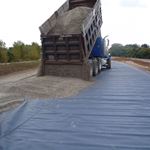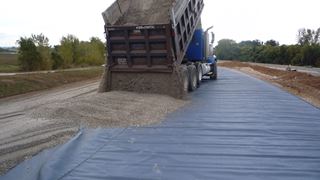Case story
Railway Reinforcement- Edmonton, AB
Canada, Alberta, Edmonton
Case Study Form
|
Application |
Railway Reinforcement |
Job owner |
Canada Pacific |
|
Location |
Edmonton, Alberta |
Engineer |
Clifton Associates |
|
Product |
Mirafi® RS580i and H2Ri |
Date of Installation (m/y) |
2016 |
THE CHALLENGE
Canadian Pacific continued investment in their infrastructure in recent years helped make CP the safest Class I railroad in North America for the last 10 years. CP continues to invest in its network to enhance safety, improve efficiency, create velocity, and provide the best service possible to customers. CP’s continuous rail maintenance and safety program identified a section of track on a site located 30 minutes, northeast of Edmonton, Alberta that was subject to track settlement resulting in cross level variations. CP implemented a 10 mph speed restriction on the section of track and scheduled it for immediate repair.
Canadian geotechnical engineering firm with expertise in railway infrastructure, was brought on board by CP to investigate potential causes and prescribe a repair. Field investigations showed that a significant amount of moisture was present in the subgrade and surrounding area. Signs of mud-pumping (movement of subgrade material into the coarse ballast) were apparent along the track surface, indicating that the wet conditions were accentuating the process of subgrade attrition and that the sub ballast was no longer performing as originally intended. According to the authors, Selig and Waters of “Track Geotechnology and Substructure Management”, the primary functions of the sub-ballast include:
- Helping to reduce stresses to subgrade.
- Protect the subgrade from freezing.
- Act as a separator between the ballast and the sub-ballast.
- Prevent upward subgrade fines migration.
- Prevent subgrade attrition by ballast.
- Shed water above.
- Drain the water below.
CP and Clifton Associates had successfully used a combination of nonwoven geotextile, triangular geogrid, and cellular confinement products to rehabilitate similar sections of rail. The railway was interested in options that would continue to reduce ballast/sub-ballast requirements, protect the ballast from fouling long term, and assist with protection against frost heave and high moisture content subgrades.
THE DESIGN
Both parties had read about the performance of TenCate Mirafi® RS580i high strength woven geosynthetic in other third-party studies/projects and reached out to TenCate Geosynthetics for a proposal. TenCate performed AREMA analyses using the Talbot equation for various subgrade conditions. The options provided to CP and Clifton Associates included single layer (1 layer of geosynthetic between the sub-ballast and subgrade) and double layer (1 layer of geosynthetic at the sub-ballast/subgrade interface and a second layer at the sub-ballast/ballast interface) dependent upon the results of a geotechnical investigation and determination of the subgrade strength. Due to the urgent nature of the repair, CP ultimately decided to select the TenCate solution for the assumed worst-case subgrade condition which incorporated Mirafi® H2Ri wicking geosynthetic at the subgrade and Mirafi® RS580i at the sub-ballast/ballast interface. Generally, the weaker the subgrade, the more benefit the geosynthetic provides. Another important factor in the decision to try the TenCate solution was to decrease track down time.
THE CONSTRUCTION
In this instance, the inclusion of the 2 layers of Mirafi® geosynthetic resulted in a 43% reduction in the amount of ballast and sub-ballast required which would also correspond to a significant savings in time related to placement, spreading, and compaction. Repair of the first 22-meter-long section was completed in just under 7 hours. Removal of the track panel and excavation/removal of the existing rail embankment was completed in approximately 1 hour. Mirafi® H2Ri was placed on the prepared subgrade, backfilled with subballast, and compacted in under 90 minutes. The sequence of events from this point onward was placement of the Mirafi® RS580i, reconnection of the track panel, ballast placement, ballast compaction and grade correction with the regulator; Placement of the geosynthetic was a minimal amount of the 4 hours required to perform these last steps.
CP will be monitoring the track performance on the repaired subgrade over the next few years. The expectation is that they will know the level of performance after the first Spring freeze, when the subgrade is expected to have the maximum moisture content.









.jpg?w=40&h=40&action=crop)